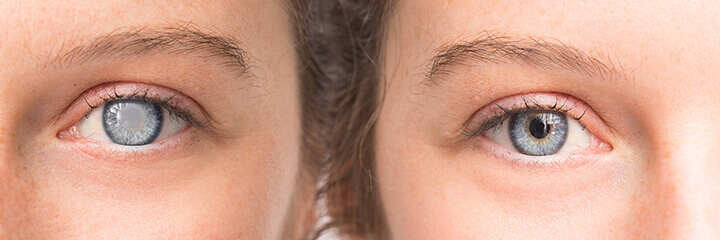During cataract surgery, an artificial lens is used to replace the damaged lens. When you have foggy vision, an ophthalmologist will perform a routine and secure treatment. The decision to get cataract surgery relies on how tough daily tasks are for the patient.
What is a Cataract?
Cataracts are progressive in nature and get worse as you age. Age plays a major role in the presence of cataracts. Cataracts are characterised as foggy, fuzzy, or opaque vision.
How do Cataract Occurs?
To create a crisp and undistorted vision, the natural eye lens directs light onto the retina. This lens can become clouded, which causes distorted and blurred images. Usually, it affects both eyes, although occasionally, cataracts in one eye may grow quickly. Complete blindness could ensue from delayed medical care.
What are the Causes of Cataracts
Trauma to the eye, smoking, diabetes, excessive alcohol consumption, prolonged exposure to sunlight or UV rays, and chronic corticosteroid usage are a few causes of cataracts along with aging. Cataracts can also be present in children as a congenital condition.
Examination of the eyes
A quick eye exam can detect cataracts. The eye exam includes a vision test as well as a slit lamp microscopic examination of your eyes. To get a better look at the retina and optic nerve at the back of the eye, special eye drops are used to dilate the pupils.
Signs of a cataract
- Trouble seeing at night.
- Trouble reading or watching TV
- Becomes tougher driving at night or in strong light.
- Requiring help in reaching places or seeing things while doing regular tasks such as walking, cooking, shopping, or other
- Another indication of cataracts is glare or sensitivity to light.
- Double vision, is also a common sign.
- Double vision, is also a common sign.
- Patients frequently require periodic modifications to their spectacles.
Treatment for Cataracts in Ghatkopar
The thickened eye lens that causes cataracts can be treated by replacing the damaged lens with a new lens. In ophthalmologist clinics all around the world, cataract removal is a common medical procedure with few associated complications. For those seeking treatment, the cataract surgery cost in India is relatively affordable compared to other countries, making it a popular destination for medical tourism. The cost can vary depending on the clinic and the type of lens used, but India offers high-quality care at competitive prices.
How to Prepare for Cataract Treatment?
- Your doctor calls you for an eye exam to determine which eye lens is best for you.
- It is advised to refrain from eating for 12 hours before surgery on the day of the procedure.
About Cataract surgery without blades
The FEMTOSECOND LENSX LASER, manufactured by ALCON, USA, is used to conduct cataract surgery at Deevine Eye Care, Ghatkopar, employing the most recent robotic technology. Our eye physicians and eye surgeons in Ghatkopar, Mumbai, are performing a laser cataract procedure that has been approved by the US FDA. This guarantees a fully blade-free procedure with a high degree of precision and fantastic visual outcomes. With the use of this technology, the procedure is extremely safe and the likelihood of any consequences is extremely low.
The Cataract Operation with the Femtosecond Laser
- The majority of cataract surgery procedures are now carried out using a femtosecond laser rather than by hand, reducing the possibility of human error and increasing accuracy.
- The cuts or incisions on the cornea made by femtosecond laser are equivalent to those made by a blade in the past. These incisions are completely self-seal, so they don’t require sutures and heal quickly.
- For premium IOLs like toric and multifocal IOLs, the capsulorhexis can be adjusted in size, and one can get a perfectly centred capsulorhexis to provide perfect IOL or lens alignment and better results.
The advantages of cataract treatment at Deevine Eye Care in Ghatkopar.
- Modern technology’s most cutting-edge
- An entirely blade-free process
- Precise results
- Increased Safety
- Customized Method
Phacoemulsification:
It is a quick process that takes less than an hour to complete. The patient is rendered pain-free by local anesthesia or sedative. The clouded lens is broken up into pieces after a laser-created small incision is produced in the cornea. The surgeon next inserts an artificial intraocular lens (IOL) after suctioning the components out of the eye.
Acrylic, silicone, or plastic can be used to make lenses. According to the needs of the patient, several intraocular lenses, including monofocal, toric, and multifocal lenses, are available for implantation.
Surgery for intracapsular cataracts:
These days, it is uncommon because this technique requires a wider incision and also removes the cataract’s surrounding capsule. In this operation, the intraocular lens is positioned in front of the iris.
Recovery after Cataract Surgery
Although the operation is typically without complications, it is nonetheless advised that you keep in touch with your surgeon following the procedure. An eye drop is initially administered to lessen irritation and shield against infection. To keep track of any issues, you will need to see the doctor frequently.
Since a cataract removal technique is a little daytime surgery, no overnight stay is required. Within a few days of surgery, the majority of patients see an improvement in their visual function, allowing them to resume most of their normal activities, including work.
After a couple of days following the treatment, the majority of patients resume normal activity. Once your vision is stabilized, your doctor may prescribe glasses for you.
Conclusion
Cataracts typically affect people over 50. It is a hereditary disorder that is rarely observed in children. The treatment of cataracts requires surgery, which can be done with only a little sedative and local anesthesia. The cataract surgery is usually without discomfort, and the patient can resume routine life in a few days with better vision. At Deevine Eye Care, our surgeons ensure the best outcome for cataract treatment in Ghatkopar through the latest advancements in technology.

